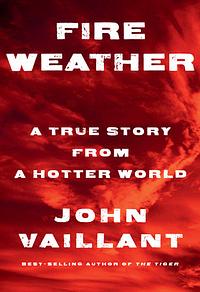Take a photo of a barcode or cover
emotional
hopeful
informative
reflective
sad
slow-paced
informative
reflective
medium-paced
It might be a bit of albertan bias but this was an absolute treasure to read. It was moving. It was poetry. It was devastating. It instilled its own fire in me to ensure that all in the world that has been lost to fire not be in vain. Thank you to Vaillant for writing this.
dark
informative
sad
medium-paced
dark
informative
reflective
sad
slow-paced
challenging
informative
medium-paced
informative
tense
fast-paced
Fire Weather by John Vaillant. On May 1, 2016 in Alberta, a wildfire erupted outside of Fort McMurray, a rural city who existence is owed to the bitumen-saturated soil of the Canadian boreal forest. Unseasonably high temperatures and extremely low humidity joined forces with favorable winds to feed a wildfire that would generate lightning, fire tornados stretching miles into the sky, and ultimately force the evacuation of 88,000 people for over a month. The Fort McMurray Fire was finally extinguished on August 2, 2017 after causing $10 billion in damage, destroying 3,500 structures, and burning more than 500,000 acres of land. Fire Weather tells the gripping, minute by minute account of the devastation with thorough reporting on the lived experiences of fire fighters, local officials, and civilian evacuees of Fort McMurray, but the compelling play-by-play of the tragedy in Fort McMurray is only part of the story. The Fort McMurray Fire was not a freak occurrence, nor an unpredictable one. The fire is believed to have been started by humans in the wilderness flanking the city, but Vaillant convincingly traces the true spark of the Fort McMurray Fire to the exploitation at the core of Capitalism, the hubris of corporations, states, and banks perpetuating the fossil fuel industry, and the inherent entitlement of settler colonialism. The story of the fire and the damage it wrought is bracing, but the latter third of the book, which systematically dismantles climate change skepticism and demonstrates the unequivocal and geological impact of our burning of fossil fuels on the world we live in, is incredibly convincing. Vaillant’s reporting of the fire is as robust as his reporting on centuries of climate science predicting the world we live in now and a world worse yet to come. A world where fire seasons are year round. A world where fires burn with the force and energy of atomic weapons. A world where wildfires create as much CO2 as volcanic eruptions. A world that burns from Greenland to Tasmania. A world we have built and aren’t prepared for. Highly Recommend.


